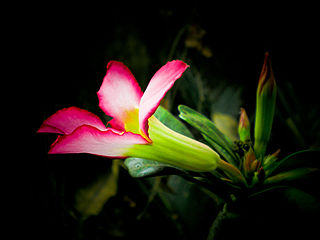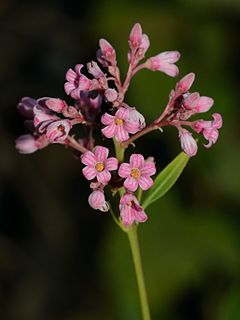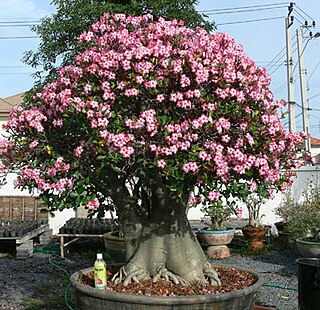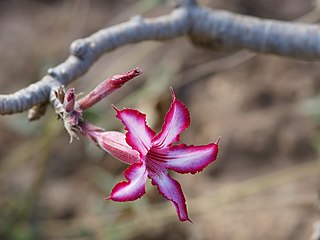
Apocynaceae is a family of flowering plants that includes trees, shrubs, herbs, stem succulents, and vines, commonly known as the dogbane family, because some taxa were used as dog poison. Members of the family are native to the European, Asian, African, Australian, and American tropics or subtropics, with some temperate members. The former family Asclepiadaceae is considered a subfamily of Apocynaceae and contains 348 genera. A list of Apocynaceae genera may be found here.

Pachypodium is a genus of succulent spine-bearing trees and shrubs, native to Madagascar and Africa. It belongs to the family Apocynaceae.

Nerium oleander, most commonly known as oleander or nerium, is a shrub or small tree belonging to subfamily Apocynoideae of the dogbane family Apocynaceae and is cultivated worldwide in temperate and subtropical areas as an ornamental and landscaping plant. It is the only species currently classified in the genus Nerium. It is so widely cultivated that no precise region of origin has been identified, though it is usually associated with the Mediterranean Basin.
A storage organ is a part of a plant specifically modified for storage of energy (generally in the form of carbohydrates) or water. Storage organs often grow underground, where they are better protected from attack by herbivores. Plants that have an underground storage organ are called geophytes in the Raunkiær plant life-form classification system. Storage organs often, but not always, act as perennating organs which enable plants to survive adverse conditions.

Adenium is a genus of flowering plants in the family Apocynaceae first described as a genus in 1819. It is native to Africa and the Arabian Peninsula.
Desert rose may refer to:

Daphnis nerii, the oleander hawk-moth or army green moth, is a moth of the family Sphingidae. It was described by Carl Linnaeus in his 1758 10th edition of Systema Naturae.

Apocynoideae is a subfamily of the flowering plant family Apocynaceae. It contains about 78 genera with roughly 860 species. Several genera are of pharmacological interest - notably those - such as Strophanthus - which have furnished highly effective arrow poisons, due to their cardiac glycoside content. The subfamily includes many species with flowers of considerable ornamental value, the best-known of which is Nerium oleander, the familiar Oleander. It also contains the remarkable pachycaul genera Adenium and Pachypodium.

Adenium obesum is a poisonous species of flowering plant belonging to tribe Nerieae of subfamily Apocynoideae of the dogbane family, Apocynaceae, that is native to the Sahel regions, south of the Sahara, and tropical and subtropical eastern and southern Africa and Arabia. Common names include Sabi star, kudu, mock azalea, impala lily and desert rose.

Pachycauls are plants with a disproportionately thick trunk for their height, and few branches. The word is derived from the Greek pachy- meaning thick or stout, and Latin caulis meaning the stem.

Adenium arabicum is a species of plant commonly used for bonsai and cultivated for its leaves, growth form and flowering characteristics.

The Desert Garden Conservatory is a large botanical greenhouse and part of the Huntington Library, Art Collections and Botanical Gardens, in San Marino, California. It was constructed in 1985. The Desert Garden Conservatory is adjacent to the 10-acre (40,000 m2) Huntington Desert Garden itself. The Garden houses one of the most important collections of cacti and other succulent plants in the world, including a large number of rare and endangered species. The 3,000-square-foot (280 m2) Desert Garden Conservatory serves The Huntington and public communities as a conservation facility, research resource and genetic diversity preserve. John N. Trager is the Desert Collection curator.

In botany, succulent plants, also known as succulents, are plants with parts that are thickened, fleshy, and engorged, usually to retain water in arid climates or soil conditions. It is a characteristic that is not used scientifically for the definition of most families and genera of plants because it often can be used as an accurate characteristic only at the single species level. The word succulent comes from the Latin word sucus, meaning 'juice', or 'sap'. Succulent plants may store water in various structures, such as leaves and stems. Some definitions also include roots, thus geophytes that survive unfavorable periods by dying back to underground storage organs may be regarded as succulents. In horticultural use, the term succulent is sometimes used in a way that excludes plants that botanists would regard as succulents, such as cacti. Succulents are often grown as ornamental plants because of their striking and unusual appearance, as well as their ability to thrive with relatively minimal care.

Adenium multiflorum is small, succulent tree native to central and eastern Southern Africa. Like other succulent members of the family Apocynaceae, A. multiflorum has a milky latex with toxic alkaloids, specifically Cardiac glycosides. This latex is used as an arrow poison and as a fish stunning poison.

Adenium boehmianum, the Bushman poison, is a poisonous succulent endemic to the mostly dry regions of northern Namibia and southern Angola. The San people boil the root sap and latex to prepare arrow poison, which is sufficient for hunting large mammals, as it contains strong cardiotoxic effects. The leaves, borne only for three months a year, are arranged spirally and are clustered near the branch tips. A plant will flower for only a few weeks in winter. The oblong fruit releases many seeds through a longitudinal slit, which due to their lateral tufts, can be dispersed by wind.
Bushman poison can refer to a number of plants or insects used as ingredients by the San people when preparing arrow poisons:

Buffalo Springs National Reserve is a protected area in the Isiolo County in northern Kenya.

Adenium oleifolium is a species of flowering plant in the family Apocynaceae.

The common beisa oryx, also known as the beisa oryx, is the nominate subspecies of the East African oryx native to the Horn of Africa and Kenya. It is closely related to the fringe-eared oryx. There are four species of oryx, one of which has two distinct subspecies. Although they are very similar in appearance, they have a number of distinct characteristics that allow identification. Common beisa oryx have fringed ears and black tufts of hair that extend past their ears. However, all species of oryx are compact and muscular, with relative long bodies and broad necks. There are not any marked difference between male and female oryx. The common beisa oryx enjoys feeding on a variety of grass species. They feed during the day, when the plants hold the most water. During the dry season, they feed on poisonous Adenium plants.

Gordon Douglas Rowley (1921–2019) was a British botanist and writer specialising in cacti and succulents.


















